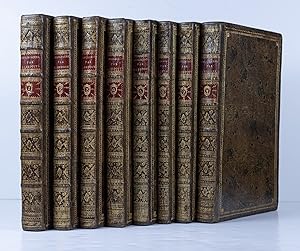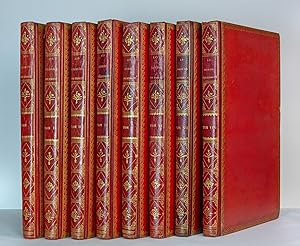redouté pierre joseph augustin pyramus candolle françois (2 résultats)
Type d'article
- Tous les types d'articles
- Livres (2)
- Magazines & Périodiques
- Bandes dessinées
- Partitions de musique
- Art, Affiches et Gravures
- Photographies
- Cartes
-
Manuscrits &
Papiers anciens
Etat
- Tous
- Neuf
- Ancien ou d'occasion
Reliure
- Toutes
- Couverture rigide
- Couverture souple
Particularités
- Edition originale
- Signé
- Jaquette
- Avec images
- Sans impression à la demande
Pays
Evaluation du vendeur
-
Les Liliacées ; par P.J. Redouté
Edité par Impremerie de Didot jeune, Paris, 1802
Vendeur : Arader Books, New York, NY, Etats-Unis
Edition originale
Hardcover. First. WITH THE PLATES BOUND ALPHABETICALLY BY GENUS IN IMITATION OF THE RARE LARGE PAPER ISSUE. Eight volumes. Paris: printed for the author by the Imprimerie de Didot jeune, 1802-1816. Broadsheet folio (20 3/8" x 13 9/16", 518mm x 346mm). [Full collation available.] Collated complete (save the title-page of vol. II and the half-title of vol. III) against Stafleu-Cowan and MacPhail in Redoutéana with 488 plates in toto, of which the 487 "botanical portraits" are stipple-engraved and colored à la poupée and finished by hand (except for pl. 372, which is black as issued). Bound in contemporary speckled and marbled calf. On the boards, a blind roll border surrounding a triple roll border gilt with corner-fleurons gilt. On the spine, six raised bands. Gilt florals in the panels. Title and author gilt to red sheep in the second panel, number gilt to red sheep in the third. Gilt roll to the edges of the boards. All edges of the text-block speckled blue. Bumps to the fore-corners throughout, with a little scuffing generally. Internally, some passages of worming (mostly at and adjacent to the boards), essentially all marginal. Scattered tanning, generally mild but on on a handful of plates moderate. Corrigenda and tables (in vol. VIII) cockled and moderately tanned. A little mild damp-staining to the fore-edge of a handful of plates in vol. V. Lacking the title-pages of voll. II and III; the dedication, usually bound in vol. I, is here bound in vol. II. Utterly unsophisticated and intact, with tissue guards at each plate (occasionally wrinkled or torn). Pierre-Joseph Redouté (1759-1840) floated above the political changes in France. He went from the patronage of Marie Antoinette -- made desinatteur du Cabinet de la Reine in 1788 -- to the dedication in the first volume (marked "year 10" of the revolutionary calendar) to "Citoyen Chaptal," back to the patronage of the Empress Josephine and on through the Restoration; doubtless had he lived into the Second Republic he would have found great favor. He haunted the gardens first of the Petit Trianon and then superintended those at the chateau of Malmaison, which Josephine had bought. Provided with the raw materials by these extraordinary women, Redouté set about illustrating. The title is somewhat misleading, since the work includes flowers from other families (irises, orchids, etc.), but Redouté's curiosity and ambition can be excused. The work stretched 14 years, with 80 livraisons (fascicles) of 6 plates apiece (the 80th having 12). The originals -- executed in watercolor on vellum, which Arader handled -- were translated into multi-color stipple-engraving; Redouté is said to have introduced the technique to France. Borrowed from Bartolozzi, it allowed faithful reproduction of color, avoiding the vagaries of individual colorists, making the book not only beautiful but reliable. The technique is laborious, and only about two hundred sets were made. Beginning in 1807 there was a parallel issue of the work issued on large paper; Redouté noted that only 18 examples were made up. This issue, which was said to have been colored by Redouté himself, was eventually bound alphabetically by Linnaeus' genera. The owner of the present set, who has left not traces of his identity, must have been aware of this useful arrangement and, not having one of the vanishingly rare large-paper sets, had his set bound aspirationally to match. Hunt, Redoutéana 10; Nissen BBI 1597; Stafleu-Cowan 8747.
-
Les Liliacées; par P.J. Redouté
Edité par Didot jeune, Paris, 1802
Vendeur : Arader Books, New York, NY, Etats-Unis
Edition originale
Hardcover. Etat : Very good. First. First edition, first state. Eight volumes. Paris: printed for the author by Imprimerie de Didot jeune, 1802 ("An X.")-1816. Folio (21 1/8" x 14", 538mm x 355mm). [Full collation available.] With an etched portrait frontispiece and 486 plates: 484 polychrome stipple-engraved plates, 1 folding polychrome stipple-engraved plate (370-371) and 1 monochrome engraved plate (372). Bound in contemporary red straight-grained morocco (over an earlier, darker red morocco; rebacked). On the boards, a gilt roll border. On the spine, seven panels separated with triple gilt fillets. In the first, third, fifth, sixth and seventh panels, a gilt floral surrounded with gilt ornaments. Title gilt to the second panel. Number gilt to the fourth panel. Fore- and bottom edges of the text-block untrimmed. With tissue guards for each plate. Rebacked. A handful of leaves (text and plates) in various volumes loose and laid in. Upper front fore-corner of vol. III and upper rear fore-corner of vol. IV strongly bumped. Fore-edges of vol. VIII with a bump. General wear to the extremities. Mostly clean internally; voll. VI-VIII with some tanning to the preliminaries and final leaves (pronounced in vol. VII, else mild or moderate). Bookplate of "De crés" on the front paste-downs of voll. I-V. Pierre-Joseph Redouté (1759-1840) floated above the political changes in France. He went from the patronage of Marie Antoinette -- made desinatteur du Cabinet de la Reine in 1788 -- to the dedication in the first volume (marked "year 10" of the revolutionary calendar) to "Citoyen Chaptal," back to the patronage of the Empress Josephine and on through the Restoration; doubtless had he lived into the Second Republic he would have found great favor. He haunted the gardens first of the Petit Trianon and then superintended those at the chateau of Malmaison in Rueil (just south of Paris), which Josephine had bought. Provided with the raw materials by these extraordinary women, Redouté set about illustrating. The originals -- executed in watercolor on vellum, which Arader handled -- were translated into multi-color stipple-engraving; Redouté is said to have introduced the technique to France. Borrowed from Bartolozzi, it allowed faithful reproduction of color, rather than depending on the vagaries of individual colorists, making the book not only beautiful but reliable. The technique is intensely laborious, and only about two hundred sets were made, with additional large-paper copies finished by Redouté himself. The title is somewhat misleading, since the work includes flowers from other families (irises, orchids, etc.), but Redoutés curiosity and ambition can be excused. The work stretched 14 years, with 80 fascicles of 6 plates apiece (the 80th having 12). Plate 95 (Tradescantia virginica) is here present in its first state (titled Commelina erecta) and Narcissus laetus is present in two states: Langlois's and Bessin's. The bookplate of "De crés" appears contemporary, but no information has been found. The presence of those plates in voll. I-V and the diminished condition of voll. VI-VIII, as well as the rebinding of morocco over morocco suggests a complex history of ownership. Dunthorne 231, Nissen BBI 1597, Stafleu-Cowan 8747.



